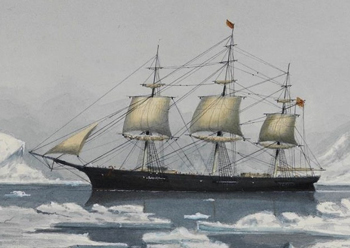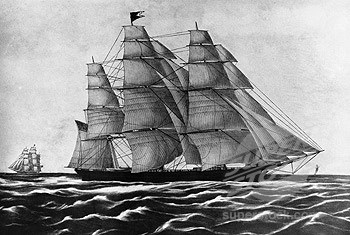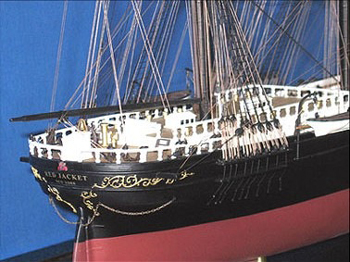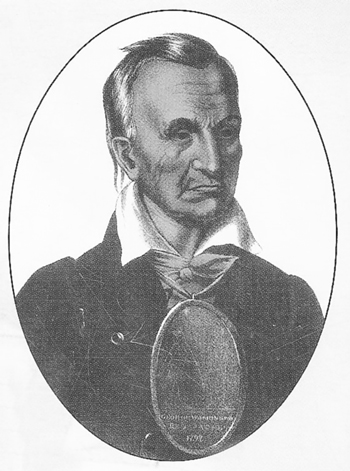The Red Jacket
by Tom Seymour

Illustration of the Red Jacket possibly making passage around Cape Horn. Raked masts and long length-to-beam ratio were characteristic of the clipper ship. The Sail, Power and Steam Museum
First-time visitors often have difficulty identifying the full-size, wooden replica of a cross-section of the famous clipper ship Red Jacket that stands fastened to the outside of one of the buildings that make up the Sail, Power and Steam Museum in Rockland, Maine.
Schoolchildren visiting the museum are especially awed by the dimensions of the ship. When standing in a line spanning the width of the replica (measured from a point amidships), 14 children can stand with an arm’s length between each person.
The day of her launching, 11 a.m., Wednesday, November 2, 1853, was an auspicious one. Hundreds of spectators from near and far gathered to witness the grand spectacle of the Red Jacket’s launching. According to a newspaper article in the Rockland Gazette, “…at the very flood of the tide and when the assembled multitudes were anxiously awaiting her motion upon the ways, she moved – steadily, gracefully, beautifully, till she was safely floating on the waters of the bay.”

The Red Jacket under a full set of sails. The Sail, Power and Steam Museum
Never was there such a beautiful clipper ship as the Red Jacket. In fact, it was said that she was the most handsome vessel ever launched by American shipbuilders. Constructed and launched in Rockland, Maine, the ship was as finely attired outside as it was outside. The Rockland Gazette offered a description of some of the wood types used in her interior construction: “Her after cabin is 22 by 22 feet, veneered with rosewood, mahogany, satin, zebra and black walnut, trimmed with gilt and finished in the highest style.”
Besides these features, the ship had a beautiful, 48-foot long stern molding featuring the bust of an (unnamed) Indian chief, complete with gilded scrollwork.

Model showing the quarter deck and dense rigging on the Red Jacket. The Sail, Power and Steam Museum
Finally, Red Jacket was equipped with 2-inch chains and corresponding anchors.
With all her grace, charm and beauty, the question naturally arose, “Would she have speed commensurate with her looks? The answer was not long in coming. After launching, Red Jacket was hauled, under tow, to New York, where she was fully rigged. Her captain was Asa Eldridge, formerly a packet ship commander. Red Jacket was manned by a crew of 65. With this, the great ship was ready for her maiden voyage, a trans-Atlantic crossing to Liverpool, England.
Red Jacket exceeded all expectations on that trip. She averaged 14.5 knots per hour and was able to top off at 17 knots per hour for sustained periods of time. This was unheard of. She made the crossing in a record 13 days, 1 hour and 25 minutes from her dock in New York to the dock in Liverpool.
Even more special, Red Jacket’s record crossing was achieved during fierce, unrelenting storms. The trip was daunting enough in good weather, but during the howling winds of November, the captain and crew had their hands full, with little time to spare for niceties.
But speed wasn’t all that Red Jacket displayed on that epic first crossing. A steamer of the Collins line, which had preceded Red Jacket by two days when leaving New York Harbor, arrived just ahead of the great ship and alerted anxious watchers that the Red Jacket was just astern.
When Red Jacket entered the harbor shortly thereafter, her captain and crew put on an amazing demonstration of ship-handling skill. Red Jacket was going too fast for tugs to throw lines to her, although they stood ready to do so if possible. At that point, it seemed as if Red Jacket must come to a disastrous landing. But her handlers knew just what they were doing. Captain Eldridge shortened sail and easily backed Red Jacket into her berth, to the amazement and wonder of the thousands of cheering onlookers.
This feat was akin to a quick-draw artist drawing his Colt revolver, twirling it, throwing it spinning in the air and having it land in its holster. Red Jacket had made her mark and grew in reputation from that day on.
Ship’s Namesake

Red Jacket, a Seneca leader who aligned himself with the British during the American Revolution. For his diplomatic efforts in the early days of the Revolution, a British officer awarded him the gift of a red coat, as worn by British soldiers at that time. The name “Red Jacket” soon superseded his original native title. The Sail, Power and Steam Museum
The Red Jacket’s figurehead, exquisitely carved by Mason of Boston, was a life-sized representation of her namesake, Red Jacket, a Seneca leader who aligned himself with the British during the American Revolution. Red Jacket, whose name as tribal chief was Sagoyewatha, did his best to avoid combat during the war. Even so, for his diplomatic efforts in the early days of the Revolution, a British officer awarded him the gift of a red coat, as worn by British soldiers at that time. The name “Red Jacket” soon superseded his original native title.
After the Revolution, Red Jacket was instrumental in the Iroquois confederation’s dealing with the United States government regarding land dealings. At that time segments of Seneca (part of the Iroquois confederacy) land was parceled into smaller reservations. And Red Jacket was there in the midst of those diplomatic efforts.
Red Jacket was also vehemently against the Iroquois nation or confederacy being assimilated into white man’s culture and advocated that his people cling to their own culture, customs and religious beliefs. As such, Red Jacket was a foe of Christianity and lobbied hard against Indians becoming Christians.
None of these qualities seem adequate to warrant Red Jacket becoming the namesake of the great clipper ship. Why he, above all others, was chosen, is not generally agreed upon. However, it may have been his great gift as an orator, rather than the subject matter of his orations, that caused the shipbuilder to name his splendid clipper ship after Red Jacket.
In addition to his beloved red jacket, Red Jacket wore an enormous silver medal, bearing the image of U.S. President George Washington, given him by Washington himself in 1792 for his part in negotiations between the Iroquois confederation, the Seneca tribe and the U.S. government. Red Jacket was instrumental in instilling a peaceful tone on the part of the Indians, which was why Washington bestowed the medal on him. Red Jacket wore his medal for the rest of his life, along with his red jacket and, after that wore out, similar-looking replacements.
Australia Trade
After docking in Liverpool, a group of Liverpool investors, along with Pilkington & Wilcox, owners of the White Star Line, purchased Red Jacket and had her fitted out for the Australian immigrant trade. To that purpose, her bottom was coppered and her cabins re-fitted to her new task.
At this point, the White Star Line chartered Red Jacket for a run to Melbourne, Australia. Captain Samuel Reid, a part owner of the ship, took her to Melbourne in 69 days. This was the second fastest time ever for that particular run.

Full-size model of a Red Jacket midship frame. The 14 school children stood at arms length for a sense of the scale of this historic ship which was built in their town. The Sail, Power and Steam Museum
The Red Jacket continued on that run for the immigrant trade until 1861, when she was re-purposed for a coastal freighter along the coasts of Australia and India. Then Thomas Ismay bought the Red Jacket in 1867, the year White Star Line was sold due to inability to pay its bills.
The ship, still part of the new and revised White Star Line, continued on in the immigrant trade under Ismay until 1872, when she joined two other clipper ships, Marco Polo and Donald McKay, for use in the Quebec lumber business. The Red Jacket hauled lumber from Quebec to London until 1883, whereupon White Star Line sold her to the Portuguese firm of Blandy Brothers in the Madeira Islands. There, she was reduced in status and stature and used as a coaling hulk. A severe gale drove Red Jacket ashore in 1885, where she ended her useful life.
Red Jacket was 251 feet long, had a 44-foot beam, a 31-foot deep hold and weighed 2,306 pounds, minus her copper hull covering. She was designed by the renowned designer Samuel H. Pook and built by “Deacon” George Thomas.
